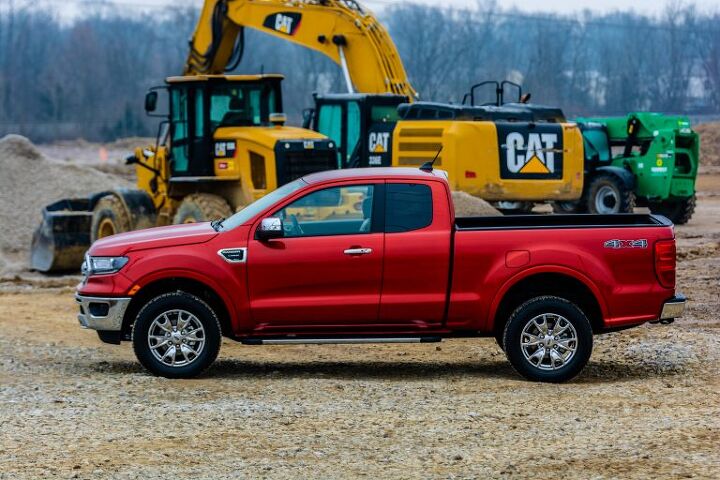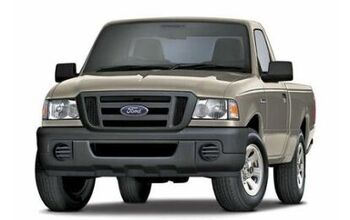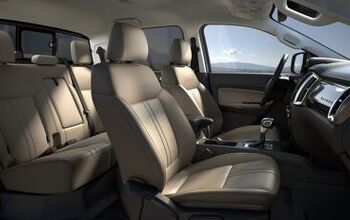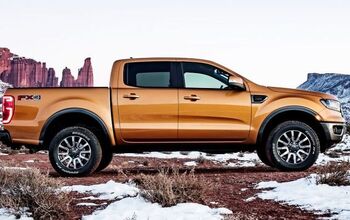2019 Ford Ranger Review - A Tweener

2019 Ford Ranger Lariat 4x4 SuperCab
You know you’re getting old when you start using phrases like “back in my day” on the regular. Indeed, as I’m rounding my fortieth lap of the sun, I find myself reminiscing entirely too much. And, considering this tidy second career I’ve picked out, it’s not surprising that my daydreams revert all too often to vehicles of my youth.
Back in my day (there it is) compact pickup trucks were everywhere. Every mainstream automaker had one – occasionally, it was a rebadged import, but it was an important segment in which to compete. The Ranger was just another player in a crowded marketplace.
These days, the compact pickup doesn’t exist in North America. The midsize truck is the new hotness, but even this segment is relatively immature. Ford looked at its overseas portfolio and saw a model that could readily be adapted – thus, the 2019 Ford Ranger seen here. Is the Ranger competitive with the stalwarts, or is it a matter of too midsize, too late?
I’ll admit to a bit of cosplay while shooting these photos. I figured I’d put the Ranger in an environment that would appear familiar – that, and it’s not hard to find a new construction site in rapidly-growing Central Ohio. While this chrome-laden Lariat trim might not see as much jobsite usage as the more work-oriented XL and XLT, this SuperCab with the long bed is best suited to a driver looking to haul tools and cargo rather than a family.
For daily driving, the SuperCrew with four traditional doors and more rear legroom would indeed be much more comfortable. As it was, my (admittedly tall) tweenaged daughters complained about the cramped quarters in the second row, and I had to remind them to close the rear-hinged doors first before the front doors. Again, it’s not a complaint about the truck itself – it’s down to choosing the right option for your needs. I’d need the larger cab.
For those taking their Ranger to the jobsite, the SuperCab is brilliant – it gives plenty of lockable storage space for expensive tools, as well as adding a longer six-foot box (versus five feet and change for the SuperCrew). No, you can’t fit plywood or drywall flat between the wheel wells (width there is 44.8 inches) but a few sheets will fit just fine either at an angle or above the wheels. Really, if you’re buying more than a few sheets of either drywall or plywood for a home project, you’ll likely get it delivered, so I wouldn’t make that a deciding factor. Likewise, the construction apprentice or journeyman driving the Ranger to work isn’t hauling a bedload of sheet goods.
I wouldn’t hesitate to haul anything within reason with the Ranger, however. The 2.3-liter turbocharged four cylinder is perfectly suited to truck duty, with 310 lb-ft of torque available at 3,000 rpm, mated to a 10-speed automatic. Payload in the bed ranges from 1,560 lbs in the SuperCrew 4×4, to 1,860 lbs in the 4×2 SuperCab. My SuperCab 4×4 is rated for 1,650 lbs.
Driving the Ranger is an unfamiliar experience to those weaned on the full-size truck. Its compact dimensions means maneuvering in the city is a much more pleasant experience. I Rangered into the notoriously narrow cobblestone streets of Columbus’ German Village with absolutely no concerns about parking (I once tried a similar excursion in a full-size truck and vowed to never do that again). The Ranger has great visibility to all corners, and responsive steering to place the truck at ease.
Of course, one traditional truck trait carries through to the Ranger – the tendency for the rear to bounce a bit on the interstate while driving without a load. Three quarters of a ton of bed payload capacity means the rear is sturdily sprung to handle that potential – and when it’s hauling, the tail gets a bit nervous at speed.
When you go to buy your Ranger, be sure to specify the locking rear differential. All that turbocharged torque will light up the inside rear tire while cornering if you aren’t particularly cautious with the throttle. Further, if you’re using that towing capacity in any place with uncertain traction, whether a muddy field or a wet boat ramp, you’ll curse the day you decided to save a few bucks. It’s a $420 option, and worth every penny. My tester, despite the extra-cost paint, the chrome package, and the Lariat trim, didn’t have it.
Speaking of that trim and chrome – it’s a bit over the top for me, but it seems to be what people like. Look at the full-sizers: the top trims ooze brightwork. I’d prefer painted trim that still looks good after a few years. I’d prefer smaller, less-bright alloy wheels. But the rest of this Ranger is an attractive truck without too much styling silliness.
If you’ve read other reviews of the newest Ranger, you’ll no doubt note a theme about the dated interior. After all, this basic truck has been for sale in other countries with few significant changes since 2011. But take a moment to consider WHO is telling you that the interior is dated – we’re auto journalists who sit behind the wheel of new cars every week. Chances are good that whomever is passing judgement upon the Ranger’s interior has recently piloted an Audi or Lexus.
Yes, there’s a good bit of hard plastic trim. Yeah, the button layout leaves some weird empty spaces on the center stack. But the Ranger works well. It’s functional, it’s solid, and it’s intuitive. Exactly what you want on frequently used control surfaces, right? It’s not an Audi. It’s not supposed to be.
About that price – as usual, media test fleets are laden with loaded vehicles, rather than the midrange volume models that fill the floorplan of your friendly local dealer. It’s hard to swallow nearly $42k for a midsize Ranger when a similarly-equipped F-150 rings the bell at around $48k. For my money, though, the value in a midsize is the ease of driving in an urban or suburban environment. You don’t give up that much in everyday capacity, but you gain confidence in being able to fit in a parking spot at Costco.
If I were to sign for a Ranger, I’d choose a SuperCrew 4×4 in Saber (a magnificent orange!) with the 301A package (SYNC 3, mostly), the $495 tow package, the $795 Technology package for the adaptive cruise control, a spray-in bedliner, and the locking rear differential. Delivered, it stickers for $38,015, and it’s a better truck for my needs.
You can keep your full-size pickup trucks. I don’t need full-size capabilities. For a daily driver that can haul toys or chores on weekends, the tweener is where it is for me. And I’d be quite happy with the tweener Ranger.
[Images: © 2019 Chris Tonn, screenshot courtesy Ford.com]

Some enthusiasts say they were born with gasoline in their veins. Chris Tonn, on the other hand, had rust flakes in his eyes nearly since birth. Living in salty Ohio and being hopelessly addicted to vintage British and Japanese steel will do that to you. His work has appeared in eBay Motors, Hagerty, The Truth About Cars, Reader's Digest, AutoGuide, Family Handyman, and Jalopnik. He is a member of the Midwest Automotive Media Association, and he's currently looking for the safety glasses he just set down somewhere.
More by Chris Tonn
Latest Car Reviews
Read moreLatest Product Reviews
Read moreRecent Comments
- ChristianWimmer Exterior and interior look pretty flawless for such a high mileage car. To me this is an indication that it was well-maintained and driven responsibly. It’s not my cup of tea but it’s bound to find an enthusiastic owner out there.And with ANY car, always budget for maintenance.
- Fred I'm a fan and watch every race. I've missed a few of the live races, but ESPN repeats them during more reasonable hours.
- Mikesixes It has potential benefits, but it has potential risks, too. It has inevitable costs, both in the price of the car and in future maintenance. Cars with ABS and airbags have cost me at least 2000 bucks in repairs, and have never saved me from any accidents. I'd rather these features were optional, and let the insurance companies figure out whether they do any good or not, and adjust their rates accordingly.
- Daniel Bridger Bidenomics working.
- Michael Gallagher Some math! The cost to produce US Shale derived oil is between $35 to $55/bbl. Middle East oil cost about $15/bbl. If OPEC wanted, they could produce more , driving oil prices below our costs and decimating our domestic industry. We have whispered in their ear that they should endeavor to keep the price above our cost, in exchange for political, economic and security favors. Case in point, during COVID when gas dropped below $2/gal , producers were losing money, Trump had to approach the Saudis requesting them to cut production to raise the oil price above our cost. If the global oil industry was truly competitive, our industry would be out of business very quickly due to our much higher cost of production. Those that long for those covid prices need to realize it would be at the expense of our domestic industry.











































Comments
Join the conversation
This is the most positive review of the Ranger I have seen, aside from the pre-introduction fluff pieces most sites always run. In most reviews where it has been actually used for more than a short time it has come in for criticism of its dated design, subpar interior design and materials, compromises made to federalize it for the N.A. market, and the poor integration of many of its features as compared to its main competitors, the Colorado/Canyon and even the ancient Tacoma. This comes through most egregiously in the few comparison tests that have been done so far. I don't know how to explain this review.
The truck I really would find useful, and would buy, is something like the '61 Scout 4x4 that was my transport in the 70s. Simple, small enough, easy to fix, and durable as anything. But nothing is made like that anymore. I'll keep looking for an early 60s Scout.......